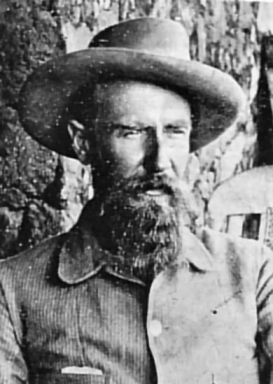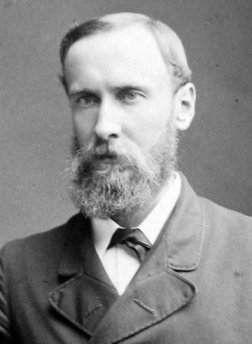View entry
Name: STOKES, Charles Henry


Birth Date: 1852 Dublin
Death Date: 15.1.1895 executed in the Congo by the Belgians
Nationality: Irish
First Date: 1876
Last Date: 1895
Profession: CMS Missionary, gun runner, arms supplier
Area: Uganda. His home was at Usongo
Married: 1. Ellen Marion Sherratt d. 1884 after childbirth 2. An African wife - Nyanjala
Children: 1. Ellen Louisa ' Nellie' (1884-1962); 2. Charles Kasaja born 1895, a few months after his father died
Book Reference: Permanent Way, Watt, Luck, Bell, Tucker, Kenyatta, North, UJ, CMS, Chandler, Ujiji
General Information:
Luck - Originally a missionary - left the mission - legally married an African wife. An ebullient Irishman - a gun runner and arms supplier.
Bell - ... Ormsby recounted how a certain Bishop, about to visit Uganda, was induced in all innocence to allow a couple of hundred porters of Stokes to join his safari, each carrying a load of guns tied up in trade cloth. Stokes was subsequently hanged by the Belgians when his reputation stank so that compensation was accepted on a monetary basis and the whole incident passed over
Tucker - May 1890 - Mombasa - I was told that Stokes, the well-known trader and caravan leader, was then in Zanzibar, and would probably be in a position to provide porters for our journey to the Lake. ......... caravan of 2500 porters led by Stokes, and his will governed this multitude of wild, untutored savages. ........ a man of great influence with the natives - a man who keeps his word with them and who never ill-treats them.
North - Former Lay missionary, CMS; Independent trader in GEA & Uganda; Leader of Bishop A.E. Tucker's 1890 CMS caravan to Uganda; trading in the Congo Free State to the west of Lke Edward Aug 1894; Summarily executed by Belgian Officer, Maj. Lothaire, for allegedly gun running to insurgents 15/1/1895; Lindi, Congo
Uganda Journal - Vol. 28, pp. 135-149 - ……… The enigma of Stokes' personality and his role in the history of East Africa have been described by Sir John Gray. Stokes was a frevent Irish protestant who went out to East Africa in 1878 under the auspices of the CMS. While in the service of the CMS he acquired skill in leading caravans into the interior, and subsequently (after marrying an African woman) severed his connection with the missionary society in favour of the more mundane activity of trading guns and powder for ivory. Stokes was a hot-tempered, passionate Irishman "with all his country's faults and virtues": - 'He was so violent and excitable that it appeared as though at times he was not quite sane. Rumours said that he was not courageous. He was easily swayed to good or evil, was vacillating in purpose, and unreliable. The making of money was the motive of his life, and anything which offered opportunities to this end was a temptation he could hardly resisit.' Stokes was "a rash hare-brained fellow, but (he) was not without his good qualities"; unlike many of his contemporaries, he treated Africans as human beings; "It was admitted on all sides that Mr Stokes was much liked by the natives, whom he always treated well …. "
……………. Lothaire was acting as the head of a small force in a disturbed district of the Congo. He appears honestly to have formed the opinion that Stokes was engaged in selling arms to the Arab chiefs, and to have drawn the conclusion that he was stirring-up war against the Congo State - a crime punishable by death. Lothaire thought that Stokes' execution was necessary as an example to the enemies of the Congo State as well as for the safety of Lothaire's own force. Stokes was captured and after a summary trial by court martial, was hanged on 15 January 1895. 'He was hoisted on two packing cases; the cord was passed around his neck; the packing cases were removed; the body fell suddenly; it was thus he died'. Lothaire and his party in the Congo learned later with "great astonishment" that this straightforward action had created bitter controversy in Europe. To those responsible for his death, Stokes was no more than a criminal whose hanging was fully justified. ………..
The British Foreign Office had no reason to look with favour on Stokes. As "an Irishman born and bred" (Stokes' own description of himself) his work in Africa was "anti-British and pro-German". Sir John Kirk, for years the British Consul in Zanzibar, remarked that "he was no loss to us, although he was an honest man ……." [lots more on case and investigation afterward]
CMS 1878 - Age 26. Of Cork. 1877 at Preparatory Institution, Reading. 1878 March 28, to Eastern Equatorial Africa - Nyanza - Mission as Lay Evangelist. Reached Uganda April 1879; left in June and returned to Zanzibar. To Uganda again, 1880, with King M'tesa's envoys. 1881, appointed caravan leader to Mission. 1882, third journey to Uganda, with fresh Missionary party. 1883, March 30 to England and Oct 2 to East Africa - Mpwapwa; 1884 Uyui; 1885 retired from CMS service and entered on trading operations on his own account. Married 1883, Jan 31 Ellen Sharratt, of the Universities Mission (one of the first 3 brave English wives who made their home in CMS EA Mission. She died at Mpwapwa, March 25 1884) (2) an African. 1895, Jan 15, executed by Belgian Officer.
Ujiji - Sadani 1878 - Charles Stokes (c. 1852-1895) - a civil engineer, served with the CMS in East Africa until 1885 when he was dismissed for marrying a non-Christian African. Stokes remained in East Africa, becoming the most important individual ivory-trader of the region. He was unjustly hanged after a mock trial by a Congo Independence State official in 1895 for allegedly supplying arms to Arabs fighting the state
Uganda Journal - Vol 14 No 1 p 32 - In 1883 Stokes had married an English lady, a member of the Universities Mission at Zanzibar; but she had died in 1884 in childbirth and her infant daughter had been sent to England to be looked after by her mother's relatives. Subsequently Stokes had severed his connection with the CMS and on 27 July 1886 he went through a ceremony of marriage at the Consulate General, Zanzibar, with a woman named Limi, who was the daughter of the paramount chief of the Wanyaturu dwelling in what is now central Tanganyika. Whilst still in missionary service Stokes had proved himself a capable caravan leader and persona grata with many of the leading chiefs in central Africa including the redoubtable Mirambo and Mutesa. After severing his connection with the CMS he established himself as a trader. In this capacity he amassed considerable quantities of ivory acquired the most part in exchange for arms and ammunition. This method of barter had called forth a protest from Mackay ………….
Complaints such as this and the personal estrangement between the two which followed upon Stokes's second marriage naturally coloured their mutual opinions of each other and serve to explain the acerbity with which each refers to the other in the course of their correspondence. …………… [more]
P.W. - July 1888 - British Agent and Consul-General at Zanzibar sent a letter to King Mwanga of Buganda by the hand of a trader named Stokes. Missionary whom Stuart and Rachel Watt met at the Coast 1885/6. He was with another Missionary called Deekes
Web In 1885 Charles married an African, Limi, a kinswoman of the new Chief of the Wanyamwesi tribe with whom he was on very friendly terms. In 1886 the couple went through the church ceremony at Zanzibar. The church immediately dismissed Charles so he set himself up as an ivory trader and cartage contractor. In this connection his marriage to Limi was very beneficial as he had the loyalty of the Wanyamwesi porters who were the best available for this work. The marriage to Limi produced no children. By this time he had assumed the
Moslem way of life and dress (but not its religion). The King of Buganda gave him two young women, Nanjala and Zaria, relatives of the Prince of Koki. Zaria was the handmaiden of Nanjala; later they were both Charles’ concubines. Charles’ business ventures prospered and in 1890 he joined the German service in their territory as an Assistant Commissioner whilst still carrying on his transport and trading activities. In 1894 he decided to organise a huge caravan of over 3000 porters and cross into the Belgian Congo to buy ivory hoping to make enough profit to be able to retire and return to Ireland. Unfortunately everything came unstuck. Unknown to Charles the Belgians had decided that all Congo ivory was to be the personal property of King Leopold which must be transported westwards down the Congo river. To enforce this decision an armed force under Captain Lothaire was sent into the area where Charles hoped to procure his ivory. Lothaire arrested Charles and, after a farcical trial by court martial, immediately hanged him. This was plain murder and caused an international furore. The British and Germans forced the Belgians to put Lothaire on trial in Boma (Congo) and, later, in Brussels, but
he was “whitewashed” on each occasion. The matter was not resolved until Queen Victoria intervened personally with her cousin, King Leopold. The Belgians eventually paid 8,000 pounds compensation to each of the British and German governments. The matter of Charles Henry Stokes adventures in Africa has been the subject of
at least two books. Mrs. Anne Luck wrote “Charles Stokes in Africa” in 1972 which was published by the East African Publishing House in Nairobi and Nicholas Harman wrote “Bwana Stokesi and his African Conquests” which was published by Jonathan Cape in London in 1986. There is also a blue paper presented to both houses of the British Parliament reporting on the death of Charles and the subsequent developments. Its title is
“The execution of Mr. Stokes in the Congo State” listed as Africa No. 8 (1896). Charles’ daughter Ellen Louisa was brought up by her mother’s relatives in Shrewsbury but a court ordered that she be placed in the care of Charles’ sister, Josephine, in Dublin. In 1908 she married George Cooper, an Irishman, kin to the Earl of
Shaftsbury. They immediately migrated to Canada and later spent fourteen years in Melbourne, Australia. They returned to Vancouver and eventually retired there. They had three daughters who all live in Canada; Marie Louise; Ellen Ruth, who married Lynn Beard (no issue) and Kathleen Courtney who married Samuel Anderson and had two sons and two daughters. Charles Stokes had two children by his concubines. Louisa was the daughter of Kabula. She died at a mission station in 1895. Photographs of Nanjala taken when she was an old lady show her to be a very dignified person. She lived to be well over 90 and died in Kampala in 1968. About 1908 Charles Kasaja was taken to Scotland by the widow of a Presbyterian About 1908 Charles Kasaja was taken to Scotland by the widow of a Presbyterian missionary, Mrs. Walker. He trained in Dundee as a medical orderly and returned to Uganda where he served the government for the whole of his working life. One of his principal tasks in his later life as to organise and conduct the blood transfusion service in that country.
